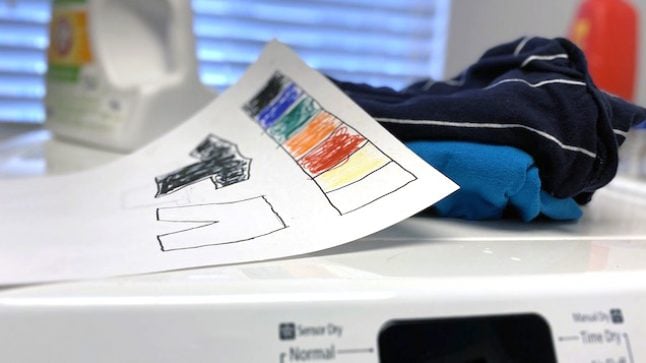Series: Ideas at Work
Let’s Wash that Math Right Into Laundry Day

Whether you have a machine at home or visit a laundromat, there is all kinds of math involved in doing laundry. And there are all kinds of ways that children of all ages can join in the thinking and doing. The washing and folding will take a little longer when you involve your “little helper” but those extra minutes of math time together are worth it!
Sort It Out
Everyone has their own rules about sorting clothes before and after washing. They all call for logical thinking that even toddlers can understand. Here’s a few ideas about turning often what feels like a chore into math conversations and games.
Clothes Toss: Put out one basket for light colors and a second one for dark colors. Let everyone take turns tossing an item from the pile of dirty clothes into the correct basket. With toddlers, cheer and give a shout out that names the rule: YAY you got your light blue shirt into the Lights basket! You might do this as a kind of bean bag game—you get 2 points for tossing an item into the correct basket; only one point if it doesn’t quite make into the basket.

Matching
Two-year-old children will enjoy finding and creating a pile of their own clothes. By the age of 3 many children are able to match socks — for themselves and others. Chat about the math, noticing and asking them about how they make a match. Older children can sort in more complex ways such as pajamas and school clothes or even type of clothing and family member who wears it.
Fold and Pile
Children ages 3 and up often enjoy folding flat items such as towels — and can get quite good at it. Lining up the corners lets children explore symmetry. As children get older, the conversations can get more elaborate. This video shows a great math conversation about shapes, colors, and fractions.
Predicting
Before sorting, encourage children to make and explain predictions about which basket is likely to end with the most items. Then talk about the results, making it math time without them even noticing.
Making Comparisons
As children get older, there are plenty of ways to keep score as tallies or graphs. This kind of keeping track allows you to chat about how your laundry stacks up.
- Tally how many items get tossed into each basket or keep a running count of how many are socks, shirts, etc. or who has the most clothes that need washing (or folding). There are all kinds of interesting measurement comparisons possible: Which type of clothing has the most? Which piles folded laundry are biggest (tallest)? Why might the pile of jeans be bigger/taller than the pile of shirts even though the number of shirts is greater than the number of jeans?
- Keep the record and use it to predict and compare to what happens the next laundry day. First-and second-graders might want to turn some of the comparisons into graphs.